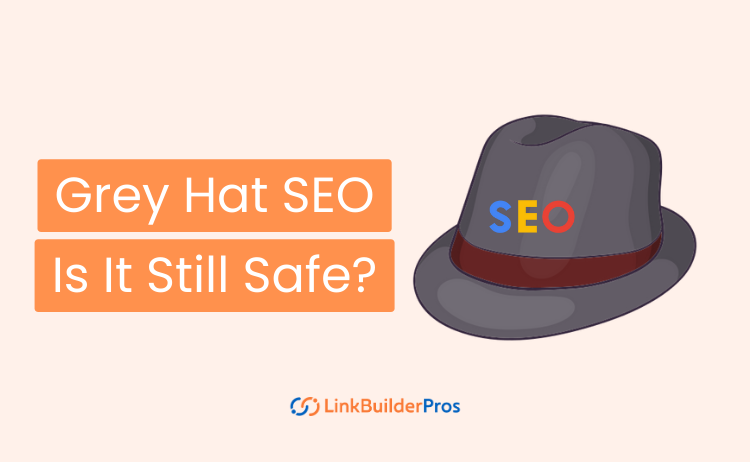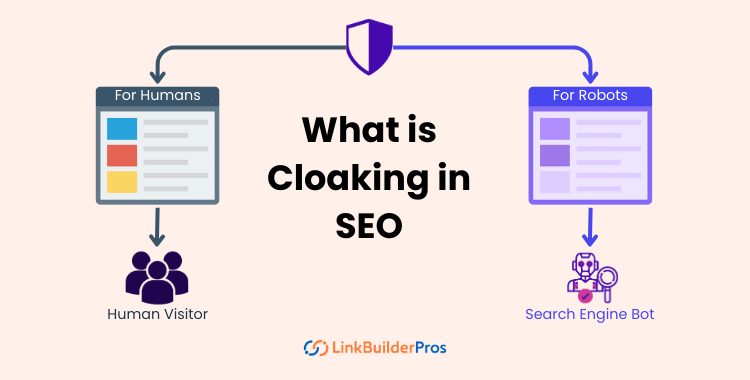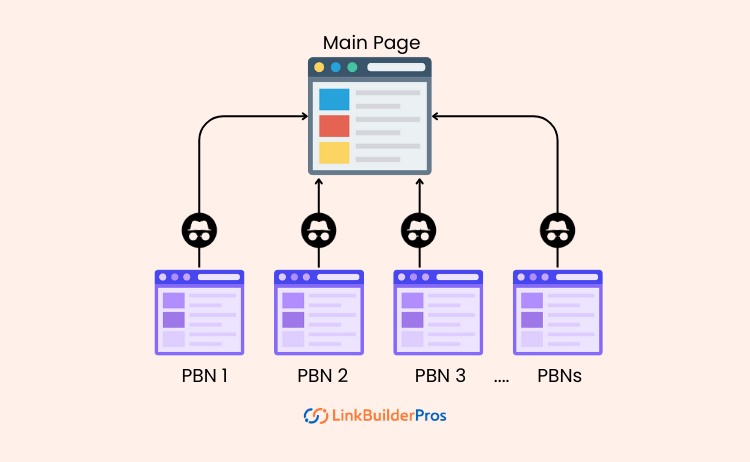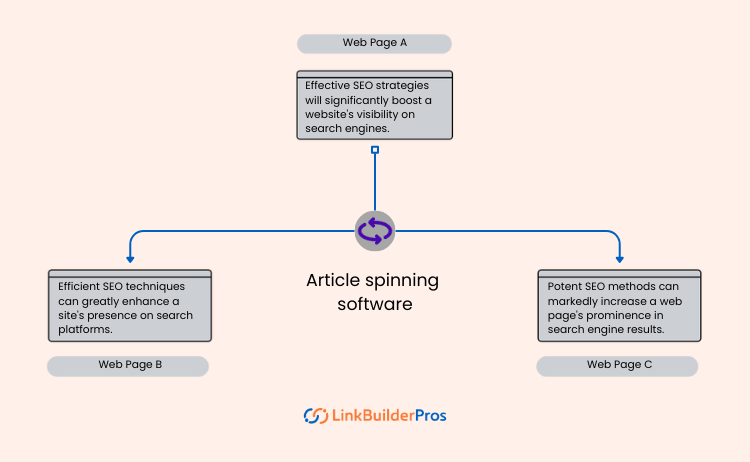Blogs
Practical Insights & Latest Happenings
Don’t miss out on the latest trends and info on SEO, search engines, social media, and more.
December 22, 2023
mothasim

What is gray hat SEO? Is it safe? Should you incorporate it into your SEO strategy?
You know Google has its own SEO guidelines for webmasters so they can rank organically by providing real value to the audience. This is what we call “white hat SEO.”
But some SEO strategies have been crafted to trick Google into thinking that “white-hat” practices are being followed while, in reality, they are misusing the guidelines for quick results. These are known as black hat SEO practices.
Grey hat is somewhere in the middle: It’s not entirely good, but it’s not entirely bad either.
That means you use tactics that are a bit edgy or push the limits of what’s considered acceptable. For instance, using slightly misleading headlines, showing different content to Google than to regular users, or playing around with keywords in a way that’s a bit more than what’s usually considered fair.
Let’s dig deeper and know more about grey hat SEO.
Grey hat SEO is a practice that falls between white hat SEO (which follows search engine guidelines) and black hat SEO (which violates these guidelines).
Essentially, grey hat SEO involves using techniques that are technically not against Google’s guidelines, but are considered manipulative or borderline unethical. While it may not result in immediate penalties, it carries a higher risk of being penalized compared to white hat SEO.
A few examples of grey hat SEO are Private blog networks (PBNs), keyword stuffing, and clickbait content.
It is important to note that the use of grey hat SEO techniques can lead to potential consequences, and sticking to white hat SEO methods is generally recommended for long-term success.
Here are Some Things to Remember about Grey Hat SEO
Here are some examples of grey hat SEO tactics, along with explanations of why they are considered grey hat and the potential risks involved –


In short, it’s a misleading approach intended to “cheat” Google’s algorithms by providing it with the type of information it prefers to see; even if visitors see something completely different. For example, showing a simplified version of a page to search engines to make it easier to crawl and index.


Grey hat SEO can be a temporary solution to boost your rankings. It can help improve your site’s credibility and visibility, which attracts organic traffic and reduces over-reliance on search engines.
However, it’s essential to be cautious, as grey hat techniques can lead to potential risks and consequences.
Understanding grey hat SEO is important because it offers a middle ground between white hat and black hat techniques. While it may improve your site’s ranking without immediate negative consequences, it also carries the risk of incurring penalties or being banned from Google. It’s crucial to weigh the potential benefits against the risks and stay informed about the latest categorizations of SEO practices.
Gray hat SEO may seem appealing for short-term gains, it’s important to consider the potential risks and long-term consequences. Use ethical SEO methods to help your website succeed long-term.
Grey hat SEO techniques, which stand in the line between acceptable and unacceptable practices, can be tempting due to their potential for quick results.
Here are the top 15 grey hat SEO techniques to be aware of in 2024-
Purchasing old or expired domains can be considered a grey hat SEO technique. This is because it involves leveraging the established SEO value, backlinks, traffic, and authority of the expired domain to quickly boost the SEO of a new website.
While this approach can provide initial benefits, it is important to note that it is not a guaranteed win and must be done carefully.
Google’s John Mueller has emphasized the need for caution when dealing with expired domains, as their use can be perceived as an attempt to manipulate search engine rankings.
Additionally, using expired domains for SEO must be augmented by other on and off-page SEO strategies to be effective. The practice of buying expired domains and redirecting them or rebuilding the expired site to backlink to the main site is a topic of discussion in the SEO community.
Some practitioners have reported success with this approach, while others have not seen significant benefits. It’s important to note that while some individuals have experienced positive results, the use of expired domains for SEO is a contentious issue within the SEO community, and its effectiveness may vary based on various factors
The mass purchasing of backlinks is seen as a gray hat SEO strategy. In this strategy, website owners obtain a huge number of links, frequently through paid means, in order to manipulate search engine rankings.
While it can lead to an immediate improvement in a site’s backlink profile, it is considered a manipulative tactic that can result in penalties from search engines.
Google’s Webmaster Guidelines explicitly state that link buying or trading constitutes “link scheming,” which is a way to game search engine algorithms and is thus frowned upon.
This technique can temporarily help a website, but it risks penalties and harms the site’s reputation long-term.
Keyword stuffing happens when you overload a page’s content, meta tags, or anchor texts with an excessive number of keywords with the intention to gain unfair ranking.
This practice is considered webspam or spamdexing and is aimed at gaining an unfair advantage in search engine results.
Google has implemented algorithms to recognize and penalize keyword stuffing, and several major updates, such as Google Florida, Google Panda, Google Hummingbird, and Bing’s September 2014 updates that have specifically targeted this practice.
Google’s guidelines emphasize that keyword stuffing results in a negative user experience and can harm a site’s ranking. Instead, the focus should be on creating useful, information-rich content that uses keywords appropriately and in context.
Cloaking shows users and search engines different content or URLs. It violates Google rules and is seen as unethical SEO.
Cloaking tries to trick search engines for better rankings. But it can lead to major penalties from Google, like lower rankings and less traffic. Common types of cloaking are user agent and IP cloaking.
Examples include hiding text, unbalanced text-to-HTML ratios, and showing HTML to search engines while displaying Flash to users.
However, cloaking is risky because search engines punish it. This can hurt a website’s reputation and long-term visibility. For sustained business success you should avoid cloaking.
Private Blog Networks (PBNs) are collections of websites and blogs built to manipulate search engine rankings. They link between each other to promote target sites and improve their search rankings.
PBNs are designed to manipulate Google algorithms that use links to measure the credibility of a website.
This is achieved by publishing unique content on those sites to make the whole network appear natural, and then using those PBNs to build links and target money sites so the ranking authority is transferred.
While PBNs can deliver quick results, they carry considerable risks of site penalties and bans. This practice is considered manipulative and is not endorsed by reputable SEO consultants, as it violates Google’s Webmaster Quality Guidelines and can result in harsh penalties, including loss of rankings or even a manual penalty.
PBNs are a risky SEO strategy and shouldn’t be used if you want long-lasting search engine success.
Creating content that doesn’t offer value refers to generating low-quality or thin content that fails to provide substantial or meaningful information to users.
This type of content often lacks depth, originality, or relevance, and it may be created solely for the purpose of filling web pages with keywords or phrases without delivering genuine value to the audience.
This kind of content can hurt a brand’s reputation and user experience by seeming fake or sales-y. Instead, content should focus on answering common questions, solving problems, and giving real value to the target audience.
Valuable content is essential for building trust, establishing thought leadership, and engaging users, ultimately contributing to brand reputation, credibility, and audience growth.
Therefore, it’s crucial to prioritize the creation of high-quality, valuable content that resonates with the audience and delivers meaningful insights or solutions.
In the world of SEO, using expired domains for backlinks can be a contentious practice. While it is possible to exploit expired domains to improve your website’s SEO, you should proceed with caution.
Expired domains might be important for their current backlink profiles, which can potentially increase the search engine rankings of your website.
However, not all expired domains are made equal, and it’s critical to carefully assess the quality and relevance of the backlinks before purchasing.
When you consider using expired domains for SEO, it’s critical to discover relevant and high-quality expired domains, extract their backlink profiles, and evaluate the backlink quality.
You should be careful using expired domains and 301 redirects to your main site. The strategy only works if the expired domains are relevant to your main site’s existing links.
Article spinning, also known as content spinning, is a technique used in search engine optimization (SEO) to create what appears to be new content from existing content.
It involves rewriting existing content to give the impression of originality by replacing words with synonyms and altering phrases, sentences, and paragraphs.
The goal is to present unique content based on facts without changing the topic. However, article spinning can lead to duplicate content issues, as it often results in content that is similar to the original source.
This practice is considered unethical and is discouraged in SEO, as it can be seen as a form of plagiarism and can deceive readers into wasting their time while not providing additional value.
Search engines like Google penalize duplicate content, making article spinning a “black hat” SEO practice that can lead to negative consequences, including a decrease in search rankings and site penalties.
Therefore, it is important to focus on creating original and valuable content rather than relying on article spinning to manipulate search results.
Social media automation uses tools to automatically schedule social media posts, reshare popular content, and manage social media accounts.
While it can reduce the time and resources spent on maintaining and growing brand accounts, it has the potential to be seen as inauthentic and manipulative.
Automated engagement tools, such as automatically following, liking, and commenting on other users’ content, can be perceived as inauthentic and may not genuinely reflect user interest or interaction.
Social media automation can help maximize reach and stay active 24/7. But it’s important to use it in ways that build credibility and relationships, not hurt them.
Use social media automation carefully. Make sure it adds to real user engagement instead of replacing it with fake automated actions.
Paying for fake reviews is a very popular technique in SEO. It is considered a grey hat SEO technique.
This practice involves fabricating or manipulating reviews to deceive search engines. It goes against Google’s policies and can lead to penalties, including the removal of biased or fake reviews and lower rankings on search engine results pages (SERPs).
Sneaky redirection brings users to a different URL from the one they requested. They trick search engines into displaying one page to crawlers and another to users.
This is against Google policy and may result in penalties such as lower search ranks. Crawlers and visitors are both directed to the same target page by legitimate redirects.
Sneaky redirects should be avoided, but good redirects help with things like changing domains. Monitoring redirects with Search Console helps ensure they don’t distort search results.
The goal is to use redirects correctly, not in a deceptive or “sneaky” way.
Historical optimization is the process of increasing the average length of older content by making minor adjustments.
This approach involves updating and republishing existing content to ensure it remains fresh, up-to-date, and relevant. By adding new information, statistics, and links, and improving the overall quality, historical optimization aims to enhance the value and performance of older content.
This practice is supported by evidence that updating old content can significantly boost traffic.
However, it’s important to approach this strategy ethically and avoid simply adding fluff to increase length. Instead, the focus should be on providing genuine value and relevance to the audience.
Historical optimization is a legitimate and effective content strategy that aligns with the evolving nature of search engine algorithms and the ongoing demand for high-quality, up-to-date content.
Engaging in blog commenting solely for link building can be considered a grey-hat SEO technique, especially if it involves spammy or manipulative practices.
This involves commenting on forums, articles, or blogs and then asking for links back to your website. While this technique is not as aggressive as black hat SEO, it is still not endorsed by search engines and can carry risks.
It’s important to note that grey hat SEO practices, including blog commenting for link building, can lead to potential penalties if detected by search engines.
Web 2.0 link building means creating backlinks to a website by posting good content on popular Web 2.0 platforms like blogs, forums, and social media sites.
The aim is to diversify the types of backlinks a website has and increase its visibility and authority in search engines.
Backlinks from reputable Web 2.0 sites signal to search engines that a website is trustworthy and provides valuable information to its users.
While this practice is often seen as a grey hat technique, it can be an effective way to improve a website’s search engine visibility and rankings.
It’s important to approach Web 2.0 link building ethically by ensuring that the content published on these platforms is high-quality, relevant, and provides genuine value to the audience.
Additionally, it’s essential to use Web 2.0 link building in moderation and as part of a comprehensive and diverse link building strategy to minimize potential risks and maximize its benefits.
Click-Through Rate (CTR) is a metric that measures the ratio of users who clicked on a specific link to the total number of users who viewed the page. While CTR is not a direct ranking signal in Google’s algorithm, it is a controversial topic in the SEO community.
Some studies and experts have suggested that CTR might influence rankings, leading to debates and experiments with click volumes and the potential manipulation of search results.
However, Google has officially stated that CTR is not a direct ranking signal. Despite this, a high CTR is generally associated with better organic search performance, as it indicates that the search result is relevant and compelling to users.
Additionally, it can be influenced by various factors such as ranking position, the presence of ads, and SERP features. Understanding and monitoring CTR is essential for optimizing search results and improving organic search performance.
Doorway pages are web pages created to rank highly for specific search queries. They often lead users to the same destination, even though they appear as different results in search engines.
However, this practice is now generally considered a grey hat SEO tactic.That means, it’s seen as deceptive and provides little value to users. Search engines like Google have updated their algorithms to penalize the use of doorway pages.
In fact, in 2015, Google announced a strategy to remove doorway pages from search results. Using doorway pages can lead to penalties, including reduced rankings or removal from the search engine index.
Therefore, it’s recommended to avoid using doorway pages and instead focus on creating high-quality, relevant content for sustainable, long-term SEO results.
Massive link exchange, which involves websites agreeing to link to each other’s content, was once a common practice to improve search engine rankings.
However, it is now viewed negatively by search engines, especially when done excessively or inorganically. Google’s guidelines discourage non-organic linking methods and excessive use of link exchanges.
While link exchanges can still be effective when done responsibly, they are generally discouraged due to the risk of penalties. It’s recommended to focus on building high-quality, organic links and creating valuable content that naturally attracts backlinks.
Negative SEO is the malicious practice of trying to harm a competitor’s visibility in search engine results. It involves using grey-hat tactics to sabotage the rankings of a competing website, such as manipulating their link profile.
This practice is unethical and can be illegal. It’s aimed at stealing keyword rankings and traffic from the target website.
While it tends to be ineffective due to search engines getting better at spotting and ignoring such attacks, it’s still important to be aware of the different types and how to deal with them
Many companies pay for premium listings on business directories and comparison sites as part of their marketing strategy. This can help attract customers who might otherwise go to a competitor.
However, overly prioritizing quantity over quality of listings can lead businesses down an unethical “grey hat” path in order to rank higher in search engines like Google.
The ideal approach is to focus on genuine citations in a few credible directories rather than trying to spam numerous low-quality sites just for more links and exposure.
Here are some grey hat SEO tactics you should avoid:
It’s important to prioritize ethical and sustainable SEO practices to ensure long-term success and avoid detrimental outcomes.
So, what’s the takeaway? If you’re looking for long-term SEO success, stick to the white hat side of the tracks. It’s the safer, more reliable route, and it’ll help you build a website that people actually want to visit.
After all, what’s the point of having a website that ranks high if nobody wants to read it?
Remember, SEO is a marathon, not a sprint. Take the slow and steady approach, focus on creating great content, and the rankings will follow.
And if you need help along the way, there are plenty of white hat SEO experts out there who can give you a hand without getting you into trouble.
Now go ahead and conquer the SEO world, the right way!
Q. How does Grey Hat SEO differ from White Hat SEO?
Ans. White hat SEO involves following the guidelines outlined by search engines, creating content based on user search intent, building links organically, and providing a pleasant user experience. Grey hat SEO, on the other hand, involves techniques that are designed to exploit search engine ranking calculations, potentially leading to penalties or rank-down.